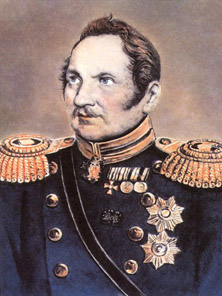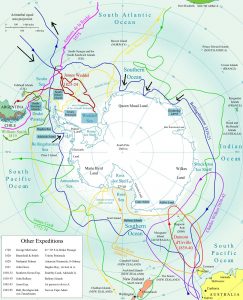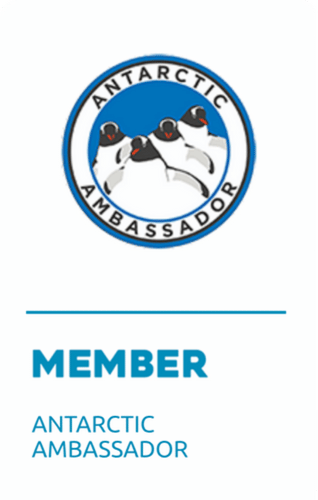Fabian Gottlieb von Bellingshausen (1778-1852)
 Fabian von Bellingshausen was a Russian naval officer who led the Russian naval expedition 1819-1921, in search of Terra Australis. His ship was the first to cross the Antarctic circle since Captain Cook in 1773; he circumnavigated Antarctica; and was the first person to sight the Antarctic continent. His orders were to explore as far south as possible and to engage in scientific work.
Fabian von Bellingshausen was a Russian naval officer who led the Russian naval expedition 1819-1921, in search of Terra Australis. His ship was the first to cross the Antarctic circle since Captain Cook in 1773; he circumnavigated Antarctica; and was the first person to sight the Antarctic continent. His orders were to explore as far south as possible and to engage in scientific work.
On June 4 1819, the flagship Vostok and transport vessel Mirnyi set sail from Kronstadt. They stopped briefly in England, where Bellingshausen met with Sir Joseph Banks, the president of the Royal Society. Banks had sailed with Cook 50 years earlier and now supplied the Russians with books and charts for their expedition.
In December 1819 South Georgia was mapped, and discoveries made in the South Sandwich Islands. It is interesting to note that icebergs supplied their fresh water needs. On January 26, 1820 Bellingshausen crossed the Antarctic Circle becoming the first to do so since Cook in 1773. His log for the following day indicates sailing to within 20 miles (32 km) of the Antarctic mainland, at a point about lat 69°21’S, long 2°14’W, and he was thus the first person to see the Antarctic continent.* Bellingshausen did not claim to have done so, but his descriptions of what he saw tally very well with what the edge of the continent here is now known to look like. Without doubt he saw the continent several more times, as he sailed eastward and attempted to penetrate further south.
On February 22 the Vostok and Mirnyi were hit by the worst storm of the voyage and were forced to sail north, arriving in Sydney, Australia in April. Bellingshausen took a month of rest, then set off on a four month exploratory cruise of the Pacific. When he arrived back in Sydney, he was notified by the Russian consul that an English sealing captain named William Smith had discovered a group of islands, which he called the South Shetlands (61° 00′ to 63° 37’S, 53° 83′ to 62° 83’W), and had proclaimed them to be part of the Antarctic continent. Bellingshausen immediately decided to undertake a second voyage south.
Vostok and Mirnyi left Sydney on November 11, 1820. Two weeks later they arrived at Macquarie Island, where Bellinghausen exchanged greetings with English and American sealers. On December 24, the ships once again penetrated the Antarctic Circle and by the January 16, 1821 they had crossed the circle no less than six different times. Each time relentless storms forced them northward.
 On January 21 the weather cleared and they spotted a dark speck against the ice in the distance. The land turned out to be an island which Bellingshausen named Peter I Island. On January 28 a number of snow-free mountains were sighted, within the 68th parallel and some 40 miles (64 km) to the south-southeast. Bellingshausen named his second discovery Alexander Coast, now known as Alexander Island. One week later they came upon eight English and American sealing ships in the South Shetlands and this is where Bellingshausen met American, Nathaniel Palmer, captain of the Hero.
On January 21 the weather cleared and they spotted a dark speck against the ice in the distance. The land turned out to be an island which Bellingshausen named Peter I Island. On January 28 a number of snow-free mountains were sighted, within the 68th parallel and some 40 miles (64 km) to the south-southeast. Bellingshausen named his second discovery Alexander Coast, now known as Alexander Island. One week later they came upon eight English and American sealing ships in the South Shetlands and this is where Bellingshausen met American, Nathaniel Palmer, captain of the Hero.
Contented, Bellingshausen sailed north. On August 4, 1821 they dropped anchor at Kronstadt, ending a voyage that had lasted two years and 21 days and covered 50,000 miles (80,467 km). Russia was unimpressed with his circumnavigation of the continent and some ten years elapsed before Bellingshausen’s detailed and meticulous account of the expedition was published. Russian interest in Terra Australis was abandoned until whaling fleets were sent to the south in 1946. Bellingshausen continued to serve his country for another 30 years, attaining the rank of Admiral. He later became Governor of Kronstadt. Russia now claims that Bellingshausen was the true discoverer of the Antarctic mainland which, ironically, they failed to recognize for 100 years.
The first Russian scientific bases Mirny and Vostock were established on the mainland during the International Geophysical Year (1957-58) and named after Bellingshausen’s expedition ships. In 1968 Bellingshausen Station was established on King George Island, by the Soviet Antarctic Expedition. Multiple other Antarctic features have been named in honor of the explorer, including Mount Bellingshausen, discovered and named by Robert Falcon Scott, and the Bellingshausen Sea, near Alexander Island.
* Edward Bransfield sighted the north-west coast of the Antarctic Peninsula at about lat 63°50’S, long 60°30’W on 30 January 1820, three days later.




